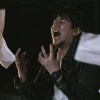Anime veteran leaves behind a legacy of more than 50 years of landmark anime including Ghibli’s Grave of the Fireflies, Pom Poko, and The Tale of the Princess Kaguya.
Most people would say that 82 years is not a tremendously short life. And yet, in a way, it feels like the time to say good-bye to anime director and Studio Ghibli co-founder Isao Takahata has come far too soon.
The 82-year-old Takahata passed away on April 5 at a hospital in Tokyo, succumbing to lung cancer after being plagued by heart and poor health conditions since last summer which had caused him to be hospitalized multiple times. An unnamed personal acquaintance was quoted as saying that Takahata looked startlingly thin when they last saw him in November. “He’d always given the impression of an inquisitive child with glimmering eyes, but [in November] he looked so tired that he seemed like a completely different person.”
Entering the anime industry as an employee of Toei Doga (the precursor to Toei Animation), Takahata would go on to have a tremendously long and successful career. A few years after he started at Toei, he met a new recruit named Hayao Miyazaki, and the two would work together on a number of projects after both left the company in 1971.
▼ The Takahata-directed Grave of the Fireflies
Takahata’s breakout work, and his theatrical directorial debut, was 1968’s Horus: Prince of the Sun, an epic fantasy on which Miyazaki served as key animator. During the 1970s, Takahata directed landmark anime TV series Heidi, Girl of the Alps and Anne of Green Gables, as well as a number of episodes of Lupin III. All became, and have remained, cultural icons in Japan even outside of the anime fan community, and once again, Miyazaki was also involved with each.
Realizing by this point that the two of them had a real knack for making anime, Takahata and Miyazaki, along with producer Toshio Suzuki, founded Studio Ghibli in 1985. In the years since, Miyazaki has gone on to be synonymous with the Ghibli name in the minds of many moviegoers, but arguably the studio’s first film to earn substantial international respect was the Takahata-directed Grave of the Fireflies (originally released in Japan in 1988).
A tragic tale of two orphans struggling, and eventually failing, to survive in Japan immediately following the end of World War II, Grave of the Fireflies, although fictional, dealt with real world events, and in an unflinching manner. That gave it an immediate sense of importance and relevance, and being a Japanese-made movie about Japan provided the cachet of being a window into a foreign society, and a mix of cultural, artistic, and even educational weight. All that resulted in solemn recommendations from mainstream English-language film critics as soon as subtitled or dubbed versions became available, even as Miyazaki’s Totoro and Nausicaa of the Valley of the Wind struggled to find acceptance overseas beyond small circles of hardcore anime fans until the late 1990s.
▼ Takahata’s Only Yesterday
In addition to Grave of the Fireflies, Takahata directed Ghibli’s Only Yesterday, Pom Poko, My Neighbors the Yamadas, and, his final film, The Tale of the Princess Kaguya, which was released in 2013. Though his films contained such fanciful elements as shapeshifting tanuki swinging their enlarged testicles as weapons and magical moon princesses, Takahata’s works are introspective and tender in comparison to Miyazaki’s bolder grand adventures, showing off Ghibli’s trademark talent in a quietly different way.
Despite his immensely impressive professional resume, Takahata spent much of his career getting little to no attention abroad. His 1970s TV work largely predates international appreciation of anime’s artistic qualities, and when Studio Ghibli did become a readily recognized name among non-anime-focused critics in the early 2000s, the primary focus was always on Miyazaki’s films, such as Spirited Away, Howl’s Moving Castle, and Ponyo. It was really only after new fans drawn in by those started looking into the older anime of not only Ghibli, but also the studio’s key personnel, that English-language critics really started to sing Takahata’s praises in chorus.
▼ The Tale of the Princess Kaguya
In a way, though, that almost seems appropriate. Takahata was borderline infamous for taking his time on projects (Miyazaki once vocally speculated that his Ghibli comrade must be “descended from sloths”), and while he developed a distinct, inimitable style, he was never the sort to draw attention to himself over the anime he created. So even if he’s no longer with us, his works, and his legacy, are still patiently waiting for anyone with a love of animation to experience.
Sources: Yahoo! Japan News/Sanspo via Jin, NHK News Web

 Ghibli anime director Isao Takahata receives France’s prestigious Ordre des Arts et des Lettres
Ghibli anime director Isao Takahata receives France’s prestigious Ordre des Arts et des Lettres Ghibli producer provokes backlash for comment regarding abilities of women to direct anime
Ghibli producer provokes backlash for comment regarding abilities of women to direct anime Studio Ghibli finishes free-to-use image release with 250 from Nausicaa, Laputa, and more
Studio Ghibli finishes free-to-use image release with 250 from Nausicaa, Laputa, and more Studio Ghibli producer dishes the dirt on Hayao Miyazaki, Your Name, and their next big project
Studio Ghibli producer dishes the dirt on Hayao Miyazaki, Your Name, and their next big project Hayao Miyazaki’s Nausicaä of the Valley of the Wind set to become live-action Japanese kabuki play
Hayao Miyazaki’s Nausicaä of the Valley of the Wind set to become live-action Japanese kabuki play Should you add tartar sauce to Japanese curry rice? CoCo Ichi makes diners an unusual offer
Should you add tartar sauce to Japanese curry rice? CoCo Ichi makes diners an unusual offer Seaside scenery, history, and so many desserts on Yokohama’s Akai Kutsu【Japan Loop Buses】
Seaside scenery, history, and so many desserts on Yokohama’s Akai Kutsu【Japan Loop Buses】 Japanese city loses residents’ personal data, which was on paper being transported on a windy day
Japanese city loses residents’ personal data, which was on paper being transported on a windy day Foreigner’s request for help in Tokyo makes us sad for the state of society
Foreigner’s request for help in Tokyo makes us sad for the state of society Red light district sushi restaurant in Tokyo shows us just how wrong we were about it
Red light district sushi restaurant in Tokyo shows us just how wrong we were about it Celebrate another year of life by putting it in jeopardy with this birthday candle flower
Celebrate another year of life by putting it in jeopardy with this birthday candle flower Anti-NHK activist recommends “magic words” that will drive away fee collectors instantly
Anti-NHK activist recommends “magic words” that will drive away fee collectors instantly Century-old Hiroshima brewery in one of Japan’s three great sake-brewing spots offers tours in English
Century-old Hiroshima brewery in one of Japan’s three great sake-brewing spots offers tours in English How do European Cup Noodles taste to a Japanese palate?
How do European Cup Noodles taste to a Japanese palate? Akihabara pop-up shop sells goods made by Japanese prison inmates
Akihabara pop-up shop sells goods made by Japanese prison inmates McDonald’s new Happy Meals offer up cute and practical Sanrio lifestyle goods
McDonald’s new Happy Meals offer up cute and practical Sanrio lifestyle goods Japanese ramen restaurants under pressure from new yen banknotes
Japanese ramen restaurants under pressure from new yen banknotes French Fries Bread in Tokyo’s Shibuya becomes a hit on social media
French Fries Bread in Tokyo’s Shibuya becomes a hit on social media Studio Ghibli releases new action figures featuring Nausicaä of the Valley of the Wind characters
Studio Ghibli releases new action figures featuring Nausicaä of the Valley of the Wind characters New private rooms on Tokaido Shinkansen change the way we travel from Tokyo to Kyoto
New private rooms on Tokaido Shinkansen change the way we travel from Tokyo to Kyoto Tokyo Tsukiji fish market site to be redeveloped with 50,000-seat stadium, hotel, shopping center
Tokyo Tsukiji fish market site to be redeveloped with 50,000-seat stadium, hotel, shopping center Beautiful Ghibli sealing wax kits let you create accessories and elegant letter decorations【Pics】
Beautiful Ghibli sealing wax kits let you create accessories and elegant letter decorations【Pics】 Studio Ghibli releases Kiki’s Delivery Service chocolate cake pouches in Japan
Studio Ghibli releases Kiki’s Delivery Service chocolate cake pouches in Japan New definition of “Japanese whiskey” goes into effect to prevent fakes from fooling overseas buyers
New definition of “Japanese whiskey” goes into effect to prevent fakes from fooling overseas buyers Our Japanese reporter visits Costco in the U.S., finds super American and very Japanese things
Our Japanese reporter visits Costco in the U.S., finds super American and very Japanese things All-you-can-drink Starbucks and amazing views part of Tokyo’s new 170 meter-high sky lounge
All-you-can-drink Starbucks and amazing views part of Tokyo’s new 170 meter-high sky lounge More foreign tourists than ever before in history visited Japan last month
More foreign tourists than ever before in history visited Japan last month New Pokémon cakes let you eat your way through Pikachu and all the Eevee evolutions
New Pokémon cakes let you eat your way through Pikachu and all the Eevee evolutions Disney princesses get official manga makeovers for Manga Princess Cafe opening in Tokyo
Disney princesses get official manga makeovers for Manga Princess Cafe opening in Tokyo Sales of Japan’s most convenient train ticket/shopping payment cards suspended indefinitely
Sales of Japan’s most convenient train ticket/shopping payment cards suspended indefinitely Sold-out Studio Ghibli desktop humidifiers are back so Totoro can help you through the dry season
Sold-out Studio Ghibli desktop humidifiers are back so Totoro can help you through the dry season Japanese government to make first change to romanization spelling rules since the 1950s
Japanese government to make first change to romanization spelling rules since the 1950s Ghibli founders Toshio Suzuki and Hayao Miyazaki contribute to Japanese whisky Totoro label design
Ghibli founders Toshio Suzuki and Hayao Miyazaki contribute to Japanese whisky Totoro label design Doraemon found buried at sea as scene from 1993 anime becomes real life【Photos】
Doraemon found buried at sea as scene from 1993 anime becomes real life【Photos】 Tokyo’s most famous Starbucks is closed
Tokyo’s most famous Starbucks is closed One Piece characters’ nationalities revealed, but fans have mixed opinions
One Piece characters’ nationalities revealed, but fans have mixed opinions We asked a Uniqlo employee what four things we should buy and their suggestions didn’t disappoint
We asked a Uniqlo employee what four things we should buy and their suggestions didn’t disappoint Princesses, fruits, and blacksmiths: Study reveals the 30 most unusual family names in Japan
Princesses, fruits, and blacksmiths: Study reveals the 30 most unusual family names in Japan Trailer for Totoro character designer’s new movie is a sampler of Ghibli’s best themes 【Video】
Trailer for Totoro character designer’s new movie is a sampler of Ghibli’s best themes 【Video】 Studio Ghibli’s The Tale of Princess Kaguya nominated for Academy Award
Studio Ghibli’s The Tale of Princess Kaguya nominated for Academy Award Your Name director Makoto Shinkai, other anime creators invited to join Oscar Academy
Your Name director Makoto Shinkai, other anime creators invited to join Oscar Academy Studio Ghibli makes us hungry for new plate collection featuring iconic characters in mid-meal
Studio Ghibli makes us hungry for new plate collection featuring iconic characters in mid-meal Studio Ghibli releases beautiful color vinyl record anime soundtrack series, available now【Pics】
Studio Ghibli releases beautiful color vinyl record anime soundtrack series, available now【Pics】 Hayao Miyazaki Working on Proposed New Anime Feature Film
Hayao Miyazaki Working on Proposed New Anime Feature Film Poster for Ghibli’s new movie under fire … from the big guru himself!
Poster for Ghibli’s new movie under fire … from the big guru himself! Toronto Film Festival to host North American premiere of Princess Kaguya, Ghibli documentary
Toronto Film Festival to host North American premiere of Princess Kaguya, Ghibli documentary Studio Ghibli co-founder Toshio Suzuki receives lifetime achievement honor at Annie awards
Studio Ghibli co-founder Toshio Suzuki receives lifetime achievement honor at Annie awards A Silent Voice, Masako Nozawa, Makoto Shinkai win Japan Movie Critics Awards
A Silent Voice, Masako Nozawa, Makoto Shinkai win Japan Movie Critics Awards Italian jazz pianist unleashes inner Ghibli fanboy, releases anime theme song album
Italian jazz pianist unleashes inner Ghibli fanboy, releases anime theme song album Studio Ghibli animator Makiko Futaki passes away at 58
Studio Ghibli animator Makiko Futaki passes away at 58 Hayao Miyazaki’s The Boy and the Heron nominated for Academy Award
Hayao Miyazaki’s The Boy and the Heron nominated for Academy Award Princess Kaguya dioramas let you decorate your home with art of Ghibli’s uniquely beautiful anime
Princess Kaguya dioramas let you decorate your home with art of Ghibli’s uniquely beautiful anime Now’s your chance to ask Studio Ghibli ANYTHING you want about Princess Mononoke
Now’s your chance to ask Studio Ghibli ANYTHING you want about Princess Mononoke
Leave a Reply